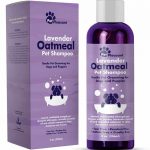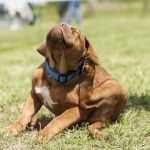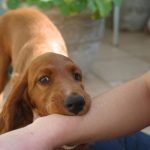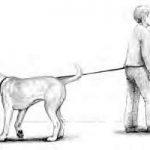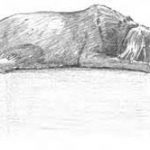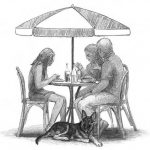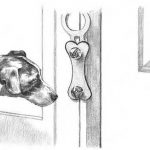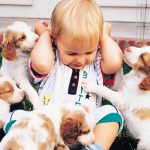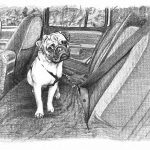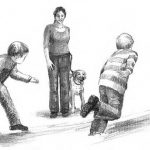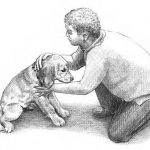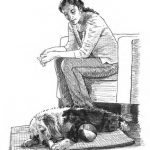Profiling the Terrier Group
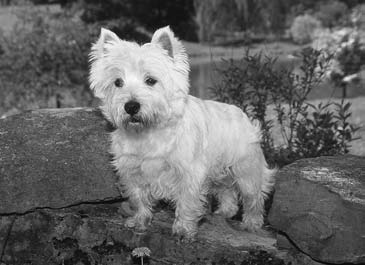

In This Chapter
In name and in spirit, the dogs of the Terrier Group are down to earth. The name terrier is derived from terra, Latin for “earth.” Farmers relied on Terriers to control pests — mice, rats, foxes — in fields and stables. These dogs were developed to pursue and kill vermin, and many did so by digging, or “going to ground,” after their prey. These Terriers had to be energetic, brave, and tenacious. For many Terriers, survival depended on their ability to fend for themselves.
During the group’s history, some were bred for sport, to kill rats in pit contests, and later to fight against each other. Fortunately, such activities are no longer legal, but the breeds as a group have retained their original feisty nature.
Today’s Terriers appeal to people who are looking for a lot of dog in a small package. In general, dogs in this group have a good disposition and can become attached to their families.
However, Terriers are not for everyone. True, they are engaging, but they require an owner with enough spunk to cope with the Terrier’s distinctive personality. On top of that, a Terrier’s level of high-energy play can be overwhelming to some people.
Although they don’t demand a lot of attention, a Terrier is likely to become bored and destructive without activities to challenge the body and mind. One way to fulfill the challenge is to test your dog in Terrier trials. Earthdog tests allow Terriers to test their skills in man-made tunnels and courses. Border, Wire Fox, Lakeland, and Scottish Terriers are just some of the breeds who live for the moment when they’re set loose to pursue some sort of critter scent or caged prey.
With their strong prey instinct intact, typical Terriers have little tolerance for other mammals, including other dogs, gerbils, and cats. They are also confident and cocky when challenged, displaying a “You talking to me?” attitude. This is good news for someone looking for a protective breed; even the smallest of the Terriers will bark to alert you to visitors, whether it’s a messenger at the door or a squirrel at the gate.
In general, Terriers are
- Feisty
- Self-assured
- Busy
- Inquisitive
- Bold
- Tenacious
- Dominant
Terriers range greatly in size and shape — the fluffy Westie and the muscular Bull Terriers bear little resemblance, although all have strong jaws to take on prey.
The Australian, Border, and Cairn Terriers are on the small side; the Airedale and American Staffordshire are bigger. The vermin-catching Terriers are roughly divided into long-legged and short-legged breeds.
Although coats can be smooth or coarse (wiry), medium or long, most Terriers are known for their wiry coats that need to be maintained with a special grooming technique known as stripping (see the chapters in Book Cleanliness Is Next to Dogliness: Grooming for information on different aspects of grooming).
Airedale Terrier
History/Evolution: Known as the “King of Terriers,” the Airedale is the largest of the group. Like other Terriers, it is believed to be a descendant of the extinct Old English Terrier. English hunters fancied its versatile hunting skills (badger, otter, and fox are just a few of the breed’s quarry). The Airedale’s intelligence, protective nature, and looks earned it many admirers when it was imported to the U.S. Whether companion, police dog, show dog, or hunter, the Airedale is truly a champion.
Size: Medium to large; males 23 inches, females slightly smaller; 45 to 70 pounds.
Color: Tan with black.
Temperament: Bold, adventurous, intelligent; can be headstrong. Good ability to learn, if things are kept fun and interesting. Protective; some can be domineering.
Energy level: High.
Best owner: Outdoorsy owner in a suburban or rural home.
Needs: Daily vigorous exercise (long walks, hunting excursion), leash, obedience training, plenty of interaction, twice weekly combing plus scissoring and shaping.
Life expectancy: 10 to 13 years.
Photograph © Jean Fogle
American Staffordshire Terrier
History/Evolution: Both the American Staffordshire Terrier (AmStaff) and the Staffordshire Bull Terrier descended from the Bulldog and a game Terrier breed. The powerful AmStaff was used in the illegal sport of dog fighting in England in the 1800s. Although sweet and docile, improper handling and training by people for fighting has left the AmStaff with a less than favorable reputation. Because of its intelligence and build, the AmStaff excels at obedience, agility, tracking, and conformation.
Size: Medium; females 17 to 18 inches, males 18 to 19 inches; 40 to 75 pounds.
Color: Almost any solid, particolored, or brindled.
Temperament: Playful, affectionate, and friendly, but protective of family; can be aggressive with other dogs. Stubborn and prone to destructive behaviors if not properly exercised.
Energy level: Medium to high.
Best owner: Active owner with previous training experience.
Needs: Daily exercise, leash, secure fences, bonding and socialization, a job, early training, minimal grooming
Life expectancy: 10 to 12 years.
Photograph © Jean Fogle
Australian Terrier
History/Evolution: Developed in Tasmania, the Australian Terrier was the first native breed to be recognized and shown in that country. A versatile dog, the Australian Terrier was bred to be an all-purpose companion and worker, able to control livestock, manage pests such as snakes and rats, and guard against intruders. Suited to life on the farm, in the city, or somewhere in between, the Australian Terrier thrives on equal doses of activity and companionship.
Size: Small; 10 to 11 inches, 14 to 18 pounds.
Color: Sandy, red, or blue and tan.
Temperament: Self-confident, spirited, and courageous. Keen and alert, although easier to quiet than some other Terriers. Friendly and affectionate; adaptable.
Energy level: Medium to high as puppies, mellows later.
Best owner: Family or active owner who enjoys training.
Needs: Daily exercise (walk or romp in park), leash, fenced yard, companionship, weekly combing plus twice yearly stripping.
Life expectancy: 12 to 15 years.
Photograph © Isabelle Francaise
Bedlington Terrier
History/Evolution: Named for England’s Bedlington Mining Shire, where it was developed in the 1800s, the Bedlington Terrier is one of the more unusual members of the Terrier Group. The lamblike appearance of the breed is deceiving; the Bedlington was bred to be a fast and skilled hunter of rat, badger, and other vermin. The Bedlington’s curly, woolly coat requires work and skill to maintain, but owners of the breed often rely on professional groomers to keep their dog’s coat in top condition.
Size: Medium; females 15 to 161⁄2 inches, males 16 to 171⁄2 inches; around 20 pounds.
Color: Blue, sandy, liver — each with or without tan points.
Temperament: Gentle, mild, and tractable; a loyal family pet. Good with children and other pets (except squeaky rodents); reserved with strangers.
Energy level: Medium.
Best owner: Active family or individual.
Needs: Daily exercise, leash, fenced yard, plenty of companionship, regular ear cleaning, combing once or twice a week, grooming to maintain shape.
Life expectancy: 15 to 16 years.
Photograph © Jean Fogle
Border Terrier
History/Evolution: The Border Terrier may be the oldest of Britain’s Terriers, originating in the 1700s in the border country between England and Scotland. The breed was used to hunt fox, which were considered a nuisance to farmers. The agile Terrier was fast enough to keep up with horses on a hunt, but small enough to go underground after a fox. Today the Border Terrier excels in agility and earthdog trials; the people-oriented breed makes a fine home companion.
Size: Small; females 111⁄2 to 14 inches, 12 to 16 pounds; males 12 to 151⁄2 inches, 12 to 20 pounds.
Color: Red, grizzle and tan, blue and tan, wheaten.
Temperament: Good tempered in the home; independent, curious chaser in the field. Good with children and pets other than rodents. Enjoys digging and barking.
Energy level: Moderately high.
Best owner: Active family or owner.
Needs: Daily exercise, leash, securely fenced yard, weekly brushing plus stripping about four times a year.
Life expectancy: 12 to 15 years.
Photograph © Jean Fogle
Bull Terrier
History/Evolution: Bull baiting and dog fighting were in vogue in England in the early 1800s, and patrons worked to breed dogs into fighting champions. Crosses between Bulldogs, various Terriers, and Dalmatians yielded the Bull Terrier, which captured the attention of the public. Despite the breed’s somewhat unapproachable appearance, the Bull Terrier is a friendly and fun-loving dog who has become popular as a devoted family pet and exceptional competitor in agility and conformation.
Size: Medium; 21 to 22 inches, 50 to 70 pounds.
Color: White, colored variety may be brindle or any color.
Temperament: Playful, mischievous, natural clowns; may be too exuberant for young children. Prone to bursts of energy; can be destructive chewers. May be aggressive with other dogs and small animals.
Energy level: High.
Best owner: Active owner in a suburban or rural home.
Needs: Daily mental and physical exercise, leash, fenced yard, human companionship, obedience training, minimal grooming.
Life expectancy: 11 to 14 years.
Photograph © Isabelle Francaise
Cairn Terrier
History/Evolution: With roots that lie in the Isle of Skye and the Highlands of Scotland, the Cairn Terrier was originally grouped with Scottish and West Highland White Terriers; the breeds began to be separated in the early 1900s. The Cairn was skilled at hunting prey such as fox that lived in the ledges and rock piles (cairns) that dotted the farming countryside. A working Terrier, the Cairn likes to be busy; today’s dogs excel in agility and tracking trials. Made famous by Toto in the Wizard of Oz.
Size: Small; females 91⁄2 inches, 13 pounds; males 10 to 12 inches, 14 pounds.
Color: Any color except white.
Temperament: Intelligent, spirited, curious, quick to learn. Can be stubborn and independent. Good with children, but may be aggressive with other dogs. Enjoys chasing and digging; some bark.
Energy level: High, but not high strung.
Best owner: Active family or owner.
Needs: Daily exercise, leash, secure fencing (to prevent digging), obedience training, weekly brushing.
Life expectancy: 12 to 15 years.
Photograph © Jean Fogle
Dandie Dinmont Terrier
History/Evolution: Named after Dandie Dinmont, a character in Sir Walter Scott’s 1814 book Guy Mannering, the Dandie Dinmont Terrier is an interesting combination of unusual but dignified appearance and hunting prowess. Overflowing with confidence for such a small dog, the Dandie would take on otters, badgers, and foxes without hesitation. Although the Dandie has retained its strong hunting instincts, the breed has somewhat “retired,” instead serving as a loyal family pet and companion.
Size: Medium to small; 8 to 11 inches, 18 to 24 pounds.
Color: Pepper or mustard.
Temperament: Intelligent, dignified, independent. Affectionate with family but reserved with strangers; aggressive toward strange dogs. Good with kids if raised with them. Bold, determined, a hunter in the field.
Energy level: Moderately high.
Best owner: Active, confident owner in a suburban or rural home.
Needs: Daily exercise (walk or exploring in a safe area), leash, secure fencing (some will dig), obedience training, twice weekly brushing plus regular scissoring and shaping.
Life expectancy: 12 to 15 years.
Photograph © Isabelle Francaise
Glen of Imaal Terrier
History/Evolution: One of the four Terrier breeds native to Ireland, the Glen of Imaal Terrier was a working Terrier, able to survive in a difficult terrain and conditions. These tough canines not only hunted rats, foxes, and badgers, but they worked the turnspit at the hearth (a dog-powered rotisserie) and fought in the pits at night. Even though the breed’s numbers dwindled for a time, the Terrier’s charm and spirit ensured its survival into modern times.
Size: Small to medium; 14 inches, 35 pounds.
Color: Wheaten, blue, or brindle.
Temperament: Spirited, inquisitive, and game for fun; ready for a chase. Docile and content with plenty of exercise. Good with older children; can be aggressive with other dogs.
Energy level: High.
Best owner: Active owner able to train a strong-willed dog.
Needs: Daily exercise (brisk walk or off-lead romp in a secure area), leash, fenced yard, involvement in family activities, regular combing as well as stripping twice a year.
Life expectancy: 10 to 15 years.
Photograph © isabelle Francaise
Irish Terrier
History/Evolution: Though the Irish Terrier’s origins are uncertain, clues have led some to believe that the old Black and Tan Terrier and the Irish Wolfhound may have contributed to this long-legged Irish breed. Black and tan, gray, and brindle were once common colors, but the solid red became standard in the late 1800s. A bold, courageous, and intelligent breed, the Irish Terrier was used as a messenger and sentinel during World War I. The breed is uncommon today.
Size: Medium; 18 to 20 inches, 25 to 27 pounds.
Color: Shades of red or wheaten.
Temperament: Assertive, brash, playful, independent; Affectionate, loyal, protective of family; usually good with children but reserved with strangers. Aggressive toward other animals.
Energy level: High outdoors but calm indoors.
Best owner: Active owner in a suburban or rural home.
Needs: Daily mental and physical exercise (hiking, hunting, agility); leash; fenced yard; early, firm, and obedience training; twice weekly combing plus shaping twice a year.
Life expectancy: 12 to 15 years.
Photograph © Isabelle Francaise
Kerry Blue Terrier
History/Evolution: Developed in Ireland, the Kerry Blue Terrier was an all-purpose farm dog — herding livestock, hunting vermin, and retrieving over land and water. It wasn’t until the 1920s that the breed became known outside of Ireland. Kerry Blues are born black, but the breed’s striking coat changes color with maturity. Though the breed has experience limited popularity as a pet, it has excelled as a police dog, as well as in herding and trailing.
Size: Medium; females 171⁄2 to 19 inches, 30 to 35 pounds; males 18 to 191⁄2 inches, 33 to 40 pounds.
Color: Blue gray when mature.
Temperament: Fun-loving, energetic, and enthusiastic. Independent; a hunter. Can be protective with strangers and aggressive toward other dogs and small animals.
Energy level: Medium.
Best owner: Active owner with training experience.
Needs: Daily mental and physical exercise, leash, fenced yard; early, firm, and consistent training; companionship, weekly brushing and combing plus monthly scissoring and shaping.
Life expectancy: 12 to 16 years.
Photograph © Jean Fogle
Lakeland Terrier
History/Evolution: One of the oldest working Terrier breeds, the Lakeland Terrier was used by farmers in the lake districts of England to kill troublesome fox and vermin. With its narrow frame, the breed was able squeeze into rocky dens to chase after quarry; later, when fox hunting became fashionable, the Lakeland Terrier joined the hunt scene. Although this former working breed is best known today as a show dog or companion, Lakelands also do well in earthdog trials.
Size: Medium to small; 13 to 15 inches, 14 to 20 pounds.
Color: Blue, black, liver, red, and wheaten; the wheaten may have a saddle of blue, black, liver, or grizzle.
Temperament: Bold, friendly, confident, and spunky. Quiet and well mannered with enough exercise. Reserved with strangers and usually aggressive toward animals.
Energy level: High.
Best owner: Active owner with training experience.
Needs: Daily exercise (walks, games), leash, fenced yard, patient and consistent training, combing once or twice a week plus some scissoring and shaping.
Life expectancy: 12 to 16 years.
Photograph © Isabelle Francaise
Manchester Terrier (Standard)
History/Evolution: Developed in England, the Manchester Terrier is a descendant of the oldest Terrier breed, the Black and Tan. The breed’s development centered on Manchester, and it was officially dubbed “Manchester Terrier” in 1860. In 1959, the Toy and the Standard Manchester were classified as one breed with two varieties. The Manchester is well suited to home life; however, its hunting instincts come to life when it detects a rodent or some other small creature that needs to be chased.
Size: Small to medium; 15 to 16 inches, 12 to 22 pounds.
Color: Black with mahogany tan.
Temperament: Observant, busy, independent, sensitive. Devoted to family, usually one person in particular; reserved with strangers. Described as catlike. Some dig.
Energy level: High, but not hyper.
Best owner: Active owner with time for companionship.
Needs: Daily exercise (moderate walk on leash, off-lead romp in a secure area), leash, fenced yard, consistent obedience training, soft bedding, minimal coat care.
Life expectancy: 15 to 17 years.
Photograph © Isabelle Francaise
Miniature Bull Terrier
History/Evolution: Truly a smaller version of the Bull Terrier, the Miniature Bull Terrier shares the Bull Terrier’s early history. When the Bull Terrier breed was developed in the 1800s, many were as small as today’s Miniatures; eventually, differences in size led breeders to divide the Bull Terriers into the Miniature and Standard groups. The AKC accepted the Miniature Bull Terrier in 1991.
Size: Small; females 12 to 14 inches, males 13 to 15 inches; 15 to 35 pounds.
Color: White or colored — any color, including brindle.
Temperament: Lively, playful, mischievous, fearless. Even tempered, sweet, but not overly devoted. Independent and stubborn. May be too boisterous for small children.
Energy level: Moderate.
Best owner: Confident owner with time for daily walks and play.
Needs: Daily exercise, leash, fenced yard, patient obedience training, a rodent-free home (for example, hamsters and guinea pigs), occasional brushing.
Life expectancy: 10 to 14 years.
Photograph © Jean Fogle
Miniature Schnauzer
History/Evolution: Developed in Germany in the 1800s, the Miniature Schnauzer may have been the result of crossing Affenpinschers and Poodles with small Standard Schnauzers. The Miniature, the smallest and the most popular of the Schnauzers, was exhibited in Germany as a distinct breed in 1899; the AKC separated the Standard and Miniature in 1933. Today the breed is prized for its protective nature, charm, and dapper good looks.
Size: Small; 12 to 14 inches, 13 to 20 pounds.
Color: Salt and pepper, black and silver, and solid black.
Temperament: Alert, spirited, playful, and friendly. Intelligent, but can be stubborn. Good with children. Some bark. Thrives when included in a family’s activities.
Energy level: Moderately high.
Best owner: Active, attentive owner.
Needs: Daily exercise (moderate walk will do), leash, fenced yard, human companionship, fun training methods, combing once or twice a week plus scissoring and shaping every two months, regular dental care.
Life expectancy: 12 to 14 years.
Photograph © istockphoto.com/ Simon Ivarsson
Norfolk Terrier
History/Evolution: For much of their early history in England, the Norfolk Terrier and the Norwich Terrier were believed to be different varieties of the same breed — the Norfolk with drop ears and the Norwich with prick ears. Not until the 1930s did breeders begin to separate the varieties. Though today’s Norfolk is not the ratter of its heyday, the breed still loves a good chase when out and about with its owner.
Size: Small; 9 to 10 inches, 11 to 12 pounds.
Color: Red, wheaten, black and tan, and grizzle.
Temperament: Energetic, bold, and feisty. A Terrier at heart; curious, independent, stubborn, loves to hunt and dig. Affectionate and loyal. Good with children when raised with them.
Energy level: High.
Best owner: Active owner in a suburban or rural home.
Needs: Daily exercise (short to moderate walk, hike), leash, fenced yard, positive training methods, human companionship, combing once or twice a week plus hand stripping three or four times a week.
Life expectancy: 12 to 15 years.
Photograph © Jean Fogle
Norwich Terrier
History/Evolution: Developed in England, the Norwich Terrier and Norfolk Terrier were once believed to be separate varieties of the same breed; eventually, the two were separated into distinct breeds (see Norfolk Terrier), with the prick-eared dog as the Norwich. Though small, the Norwich was an eager worker and a formidable force in ratting and fox hunting. Today the breed excels in the show ring but has experienced limited popularity as a pet.
Size: Small; 10 inches, 10 to 15 pounds.
Color: Red, wheaten, black and tan, and grizzle.
Temperament: Fearless, amusing, affectionate, adaptable. Independent; can be a training challenge. Loyal, sensitive companion; good with children, especially when raised with them.
Energy level: High, but can vary with owner.
Best owner: Active, patient owner.
Needs: Daily exercise (short walk or run; avoid heat and humidity), leash, fenced yard, patient housebreaking, obedience training, combing once or twice a week plus stripping twice a year.
Life expectancy: 12 to 15 years.
Photograph © Jean Fogle
Parson Russell Terrier
History/Evolution: Named for the Reverend John Russell, an English huntsman of the 1800s, the Parson Russell Terrier was first bred to hunt fox. Subsequent crossings led breeders to change the name to the more commonly recognized Jack Russell Terrier, but the AKC reinstated the original name in 2003. The breed’s weatherproof coat can be wire-haired or smooth. Although the breed has experienced a jump in popularity (as “Eddie” on the sitcom Frazier), it is not a breed for everyone.
Size: Small; 12 to 14 inches, 13 to 17 pounds.
Color: White; white with black or tan markings, or a combination of these; tricolor.
Temperament: Outgoing, friendly, energetic, adventurous. A true hunter. Good with strangers and older children; may have issues with other dogs. Thrives on exercise and activity. An escape artist.
Energy level: High.
Best owner: Active owner with training experience.
Needs: Daily mental and physical exercise, leash, fenced yard, training. Weekly brushing for the smooth type; the broken coat also needs occasional hand stripping.
Life expectancy: 13 to 15 years.
Photograph © Jean Fogle
Scottish Terrier
History/Evolution: The Scottish Terrier’s early history is confusing, at best, but it’s clear that the feisty, bearded “Scottie” was one of a rugged group of Terriers used to hunt vermin in the Highlands of Scotland. Like other Terriers, the Scottie is a fast, strong breed that excelled at pursuing prey. The Scottish Terrier has enjoyed great popularity over the years, with admirers such as King James VI and President Theodore Roosevelt, and President George W. Bush.
Size: Small; 10 inches; females 18 to 21 pounds, males 19 to 22 pounds.
Color: Steel or iron gray, brindled or grizzled, black, wheaten or sandy.
Temperament: Spirited, alert, determined, ready for adventure. Loving and gentle with family (best with children over 5); friendly but reserved with strangers. Can be aggressive with other dogs. May dig or bark.
Energy level: High.
Best owner: Active owner with training experience.
Needs: Daily exercise (moderate walk, vigorous game), leash, fenced yard, obedience training, regular brushing and shaping.
Life expectancy: 12 to 14 years.
Photograph © Jean Fogle
Sealyham Terrier
History/Evolution: Developed in the 1800s in Wales, the Sealyham Terrier was named after the estate of a noted breeder of the time. A small package of power and determination, the Sealyham was an exceptional hunting dog, facing badgers, foxes, and otters without fear. Although the breed was once a fashionable accessory, associated with Alfred Hitchcock, Cary Grant, and Elizabeth Taylor, its popularity has waned.
Size: Small; 101⁄2 inches; females 21 to 22 pounds, males 23 to 24 pounds.
Color: White with lemon, tan, or badger markings.
Temperament: Friendly, charming, playful, and outgoing. Inquisitive and always ready to explore; may dig if bored. Devoted to family — best with older children — but reserved with strangers.
Energy level: Moderate to low.
Best owner: Patient owner with time for grooming.
Needs: Daily exercise (short walk or play session), leash, fenced yard, firm and consistent obedience training, early socialization, brushing two or three times a week plus shaping every three months.
Life expectancy: 12 to 14 years.
Photograph © Isabelle Francaise
Skye Terrier
History/Evolution: One of the oldest Terrier breeds, going back to the 1500s, the Skye originated off the coast of Scotland on the Isle of Skye. Farmers relied on the plucky, long-haired Skye to hunt vermin such as fox, badger, and otter. The Skye’s popularity surged in the mid-1800s when Queen Victoria declared her affection for the breed. The Skye brings its natural enthusiasm to whatever task it takes on — agility competitor, tracking champion, or loyal home companion.
Size: Short but substantial; females 10 to 12 inches, males 11 to 14 inches; 25 to 40 pounds.
Color: Black, blue, gray, silver, fawn, or cream.
Temperament: Mild mannered, loyal, and friendly; fearless hunter with surprising strength and stamina. Affectionate with family and friends; cautious with strangers, a good watchdog.
Energy level: Moderate.
Best owner: Active owner with Terrier experience.
Needs: Daily exercise, leash, fenced yard, obedience training, regular combing and an occasional bath.
Life expectancy: 12 to 14 years.
Photograph © Isabelle Francaise
Smooth Fox Terrier
History/Evolution: Though its ancestry is somewhat uncertain, the Smooth Fox Terrier originated in England in the 1700s. With its keen nose, excellent eyesight, and stamina, the Smooth Fox Terrier helped farmers eradicate vermin such as foxes. Until 1984, the Smooth and the Wire Fox Terriers were considered one breed with two varieties. Though the breed isn’t used much for hunting today, the Smooth Fox Terrier is highly trainable and does well in agility and earthdog trials.
Size: Medium; females 14 to 151⁄2 inches, 15 to 18 pounds; males 15 to 151⁄2 inches, 18 to 20 pounds.
Color: Mostly white with black and/or tan markings.
Temperament: Energetic, feisty, lively, playful; good playmate for children over 6. Reserved with strangers, excellent watchdog. Strong digging instincts; some may bark. Independent, adventurous, loves to chase.
Energy level: High, mellows with age.
Best owner: Active owner or hunter with training experience.
Needs: Daily exercise (vigorous game or walk), leash, fenced yard, firm and patient training, weekly brushing.
Life expectancy: 12 to 14 years.
Photograph © Jean Fogle
Soft Coated Wheaten Terrier
History/Evolution: One of the three large Terriers of Ireland, the Soft Coated Wheaten Terrier is prized for its abundant silky coat. Earlier in its history, the breed was developed as an all-purpose farm dog who could herd, guard, and hunt. The Soft Coated Wheaten Terrier came to the United States in 1946, and the AKC recognized it in 1973. The breed is versatile — a fine competitor in obedience and agility trials, as well as an affectionate companion in the home.
Size: Medium; females 17 to 18 inches, 30 to 35 pounds; males 18 to 19 inches, 35 to 40 pounds.
Color: Wheaten.
Temperament: Affectionate, happy, gentle, adaptable. Good with considerate children; can be too boisterous for some. Active and alert. Less aggressive than some Terriers. Adaptable. May jump and dig.
Energy level: Medium to high, mellows with age.
Best owner: Active owner with training experience.
Needs: Daily exercise, leash, fenced yard, firm and consistent training, brushing or combing every two days, and bathing and trimming every other month.
Life expectancy: 12 to 14 years.
Photograph © Isabelle Francaise
Staffordshire Bull Terrier
History/Evolution: The Staffordshire Bull Terrier’s history begins in England in the 1800s, at a time when popular sports included rat killing and dog fighting. The breed, developed from crossings between the Bulldog and the Black and Tan Terrier, was fearless, quick, and strong for its size. Today less a fighter than lover, the Staffie’s temperament has earned him a spot in many families as a devoted and affectionate companion. The breed earned AKC recognition in 1974.
Size: Medium; 14 to 16 inches; females 24 to 34 pounds, males 28 to 38 inches.
Color: Red, fawn, white, black, blue, or brindle; may have white markings.
Temperament: Amiable, fun loving, docile; good with children, but may be too strong and lively for little ones. Intelligent and determined; owners may need to earn respect with training. Perceived association with pit bulls will keep intruders away.
Energy level: Medium to high.
Best owner: Active owner with training experience.
Needs: Daily exercise, leash, fenced yard, sturdy chew toys, human companionship; early, fair, and consistent training; low heat and humidity, weekly brushing.
Life expectancy: 12 to 14 years.
Photograph © Isabelle Francaise
Welsh Terrier
History/Evolution: The Welsh Terrier originated in Wales in the 1700s, one of only two Terriers native to that country. The compact breed was renowned for its gameness and hunted otter, fox, and badger. Little has changed about the Welsh Terrier in appearance and spirit, and owners of today’s Welsh Terriers need to be mindful of the breed’s tendency to take off and chase. The breed was first brought to the United States in 1888.
Size: Medium; 15 to 151⁄2 inches, 20 to 25 pounds.
Color: Black and tan.
Temperament: Spirited, alert, friendly, and mischievous; will create own fun if not provided with outlets. Good with considerate children, but not as much with strangers and other pets (cats beware!). Tends to dig and bark.
Energy level: Medium to high.
Best owner: Active family, including a “master” with training experience.
Needs: Daily walk or play session, leash, fenced yard, obedience training and socialization, patient housetraining, combing two to three times a week plus shaping every three months.
Life expectancy: 12 to 14 years.
Photograph © Jean Fogle
West Highland White Terrier
History/Evolution: The West Highland White Terrier originated in Scotland in the 1800s, one of the Scottish Terriers used to hunt fox, badger, and other pests. The compact but hardy “Westie” was originally known as the Poltalloch Terrier, after the home of a Westie breeder; the breed was also known for a time as the Roseneath Terrier, named for the estate of the Duke of Argyle. The confident Westie excels in competitions and has become one of the most popular pet Terriers.
Size: Small; females 10 inches, 13 to 18 pounds; males 11 inches, 15 to 20 pounds.
Color: White.
Temperament: Affectionate, happy, friendly, devoted. Alert, curious, determined, loves to bark and dig. Good with considerate children but not with small animals.
Energy level: High.
Best owner: Active owner or family.
Needs: Daily exercise (short to moderate walk, backyard game), leash, fenced yard, consistent training, combing two to three times a week plus shaping every three months.
Life expectancy: 12 to 14 years.
Photograph © Jean Fogle
Wire Fox Terrier
History/Evolution: A descendant of the rough-coated Black and Tan Terrier, the Wire Fox Terrier was developed in England in the 1800s to go to ground for fox and other small game. Until 1984, the Smooth and the Wire Fox Terriers were considered one breed with two varieties. Today the Wire Fox Terrier excels in the show ring as well as earthdog trials. Owners with patience, some training experience, and a sense of humor find the breed to be a delightful home companion.
Size: Medium; females 14 to 16 inches, 15 to 20 pounds; males 15 to 17 inches, 20 to 25 pounds.
Color: Mostly white, with black and tan markings.
Temperament: Playful, energetic, adventurous, mischievous. Vocal and loves to dig. Thought to be scrappier with other dogs than the Smooth variety. Good with children, but best for those under 6.
Energy level: High, mellows with time.
Best owner: Active owner in a rural or suburban home.
Needs: Daily hike, long walk, vigorous play session, leash, fenced yard, early and obedience training and socialization, combing two to three times weekly plus shaping every three months.
Life expectancy: 12 to 14 years.
by Eve Adamson, Richard G. Beauchamp, Margaret H. Bonham, Stanley Coren, Miriam Fields-Babineau, Sarah Hodgson, Connie Isbell, Susan McCullough, Gina Spadafori, Jack and Wendy Volhard, Chris Walkowicz, M. Christine Zink, DVM, PhD


























